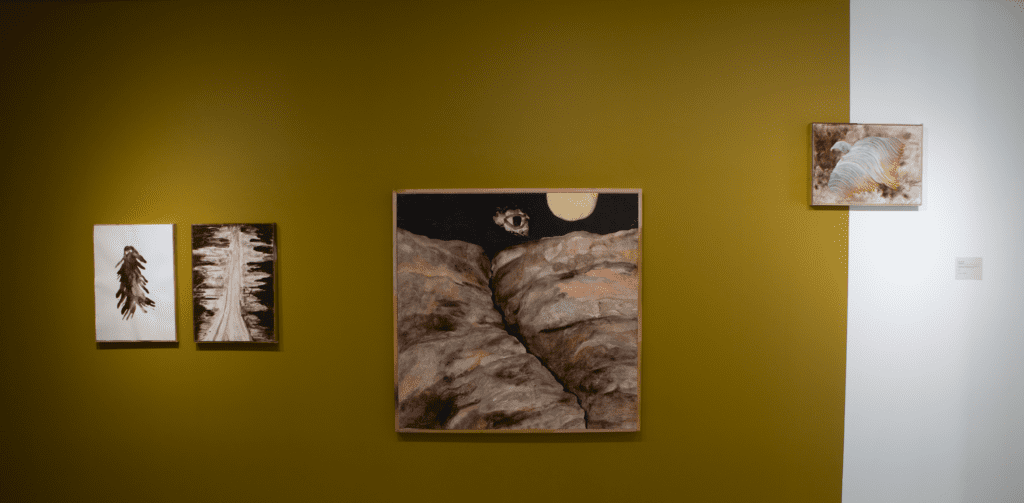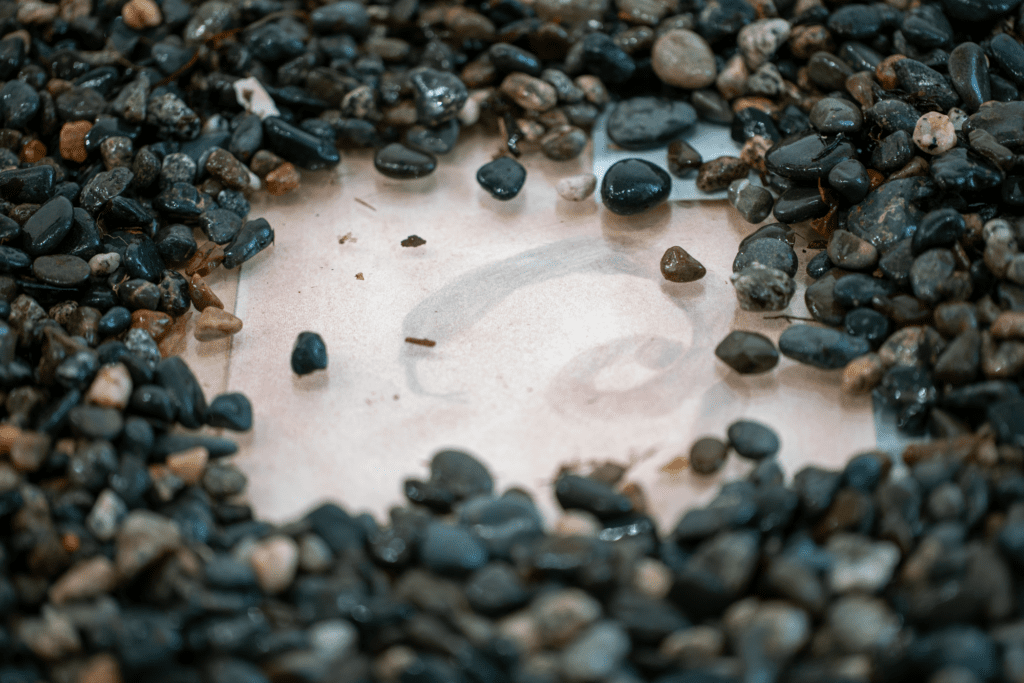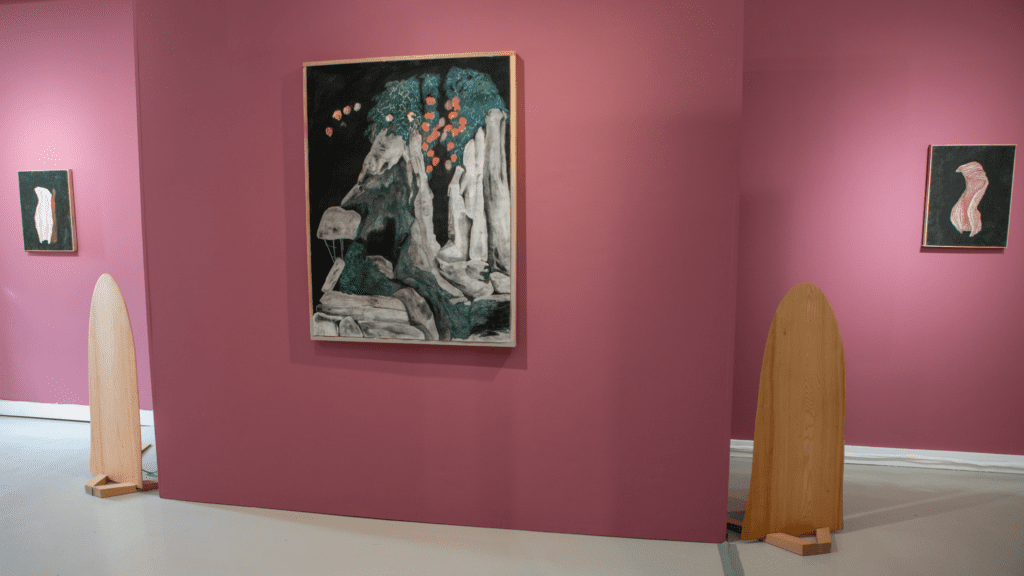Ask the Mountains at the Campbell River Art Gallery
18 October 2022By sophia bartholomew

In their exhibition Ask the Mountains at the Campbell River Art Gallery, artists Sylvie Ringer and Jenni Schine have built up overlapping pools of sound and colour, carving new depths and dimensions into the gallery, literally changing its physical topography. On a sonic level, Schine’s varied soundscapes vibrate outwards from creature-like wooden ’radians,’ built by Italian composer Giorgio Magnanensi from curved, salvaged slabs of maple and cedar. The compositions spill into different parts of the space, interacting with Ringer’s large blocks of colour to create a strong sense of passage—constructing a sense of movement through distinctive and immersive zones.
Visually and sonically, everything in the exhibition is like something else—almost but not-quite. Ringer’s drawings are face-like, sperm- or tadpole-like, mountain-like, river-and-valley-like, bone-like, stone-like, house-like, tree-like. Utilizing specific material explorations to plumb the depths of bodily memory, intergenerational inheritances, epigenetics, and memories from the womb, both artists’ forms are distinctly rooted in our observed reality while holding aesthetic interest through their inherent abstractions.

As you enter the gallery, a custom-built plywood structure for Trace Fossils in Us (2022) swells up and swallows most of the middle of the room. Though square in shape, the pathways this work proposes are circular, spiralling; it encourages visitors to circumambulate—“to circle on foot, especially ritualistically.” Ten feet wide and eight feet high, two of its exterior walls are papered with Ringer’s colour washes and drawings in overlapping layers of soft grays, yellows, ochres, oranges, and peaches, punctuated by deep tones of burgundy, sanguine, emerald, turquoise, and blue. Certain biomorphic shapes are outlined white-on-black or black-on-white, and the white-washed wood grain of the plywood peeks out in some places. Here, too, there is a sense of movement—of shuffling and sifting. The layered, composite surfaces wrap around and inward, further extending into the structure’s insides.
The remaining interior walls are painted matte black, leaving the seams, the screws, and the pocked surface of plywood unadorned and unaltered. Framed drawings stand alone or are grouped together, and small works on paper (and on Finnish wood pulp board) rest on shelves made from driftwood to form clusters. Like every aspect of this exhibition, the experience of these black, cavern-like spaces is both familiar and strange. The imagery is at once recognizable and just out of reach: evoking geodes, rivers, trees, mountains, hair, a window, a lemniscate, while also recalling interior, psychic spaces, and body-feelings, amongst other intangible perceptions. The groups of works on paper follow a familial, domestic logic—like the photos and mementos hung together in my grandmother’s home—suggesting a set of family relationships that in turn extend to the non-human and the unknown. The driftwood shelves add something childlike and fanciful, and in one place a wooden radian hangs flat overhead, speaking the most ethereal of Schine’s compositions—more of a white noise, different from the layers of abstracted beach rock sounds that dominate the rest of the space.
Beginning again from the gallery’s entrance and walking counter-clockwise along the outer edges of the room takes you through a corridor of emerald green, then a hallway of dark dusty rose, and past a golden-ochre section of wall, before you arrive at a long wall painted in pale celery. These larger surfaces of colour allow for Ringer’s individual drawings to constellate, forming larger works full of interplay and associative meaning-making. With titles like The Oracle, Messages from the Bluff, The Journey and the Witnesses, and Memories of Sediment (all 2022), each assemblage of drawings has been framed in glassless wooden frames that are rough yet delicate, sometimes spread apart and sometimes huddled together. At the centre of Otherworlds and Woods (2022), a textured barnacle-like rock-mountain grows roots underground, and the night sky horizon extends off the paper and around the frame. In Messengers (2022), a shell-like, bird-like shape hangs over the hard edge of a golden-ochre painted on the wall, emphasizing movement across this threshold.
Between the dusty rose and golden-ochre walls, a floor work is bordered by driftwood, hugging a protruding corner. Titled Call and Answer: unearthing connections (2022), this work is another collection of overlapping drawings, this time weighted under glass and covered with small pebbles borrowed from Bere Point, an orca whale rubbing beach on Malcolm Island in BC. These particular pebbles have been worn incredibly smooth. They’ve been formed not just by the movement of the waves, but by the bellies of whales rubbing against them—a cultural behaviour among whales that is specific to the Northern resident orca community. Moving the pebbles around alternately unearths and covers over different drawings, revealing bones, sticks, a moon face, a labyrinth, whales, a hairy lemniscate, human hands, and the Venus of Willendorf, as well as stone-like and wave-like and crab-like forms. The noise of the stones as you move them folds seamlessly into Schine’s sound works.

Floating above the pebbles, cloud-like, are smaller rounded radians resting on driftwood shelves. Nearby, nestled behind the celery-coloured wall, is a second cavern-like space. In this darkened screening room there is a split-screen video showing Schine and Giorgio Magnanensi rummaging around together, making sounds with stones on the beach. They stir, bounce, and drag the stone over each other, feeling and listening to them as they make the field recordings that Schine used to build her soundscapes. These recurring materials—stones and pebbles, salvaged wood, and driftwood—carry the residue of long-time contact with other bodies: water, wind, sunlight, soil, and whales, among others.
After leaving Campbell River, this work will travel north and west, adapting itself to the space of a ninety-one-year-old athletic hall on Malcolm Island, for an exhibition and set of programs hosted by the Sointula Resource Centre. The influence of Malcolm Island (a remote island off the northern coast of Vancouver Island) might not be immediately apparent, but it runs quietly through every aspect of Ringer and Schine’s collaboration. This is part of what I find so compelling about their exhibition: the sense of an ongoing relationship, changing and developing over time. Ultimately, Ask the Mountains is only one glimpse of a much longer and larger body of work. The work is portable and adaptable, but it also expands and collapses, opens and closes, and it responds differently as it moves through time and space. Throughout this transition, some of the artists’ processes are made visible, while many others remain unseen, and it is this residue of continuous change that charges the exhibition space, giving a newfound pull and power to the work.
Ask the Mountains ran from March 19 – May 21, 2022, at the Campbell River Art Gallery in Campbell River, BC.
Feature image: Installation view of Ask the Mountains by Sylvie Ringer and Jenni Schine. Photo courtesy of the artists.



